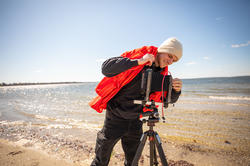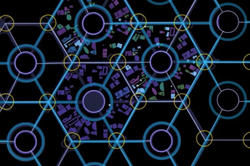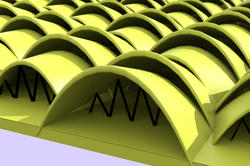RISD students working across disciplines explore the relationship between nature, art and design in third year of synergistic partnership.
RISD x Hyundai Motor Group Collaborative Continues to Produce Compelling Research
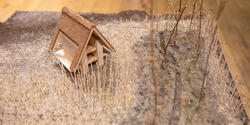
Now in its fourth year, RISD’s fruitful partnership with R&D experts at Hyundai and Kia via the RISD x Hyundai Motor Group Research Collaborative continues to merge the expertise of both organizations, producing unexpected and promising results. Annual research projects examine the links between nature, art and design, exploring speculative futures that center just societies, new ways of making and sustainability.
Building on research conducted in previous years, this year’s work focused on the theme of “Collaborative Future Living” via two courses: Coexistence in Crisis, led by Architecture faculty member Leeland McPhail, and Future Spaces and Autonomous Vehicles, led by Patty Johnson, an associate professor in RISD’s Furniture Design department. The two endeavors offered different perspectives and technological tools to explore sustainability at a variety of scales and scopes, from the interpersonal to the global. One class investigated the future of autonomous vehicles, focusing on organic interiors and energy management solutions, and the other considered non-extractive methods and materials for the construction of shelters integrated within the landscape.
“Together, we ignite a powerful synergy that transcends traditional boundaries, blending nature, technology and creativity.”
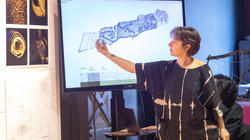
Students in both studios were mentored by Jennifer Bissonnette, director of RISD’s Edna W. Lawrence Nature Lab, and HMG Biology Programs Fellow Felipe Shibuya, who co-taught both classes. Bissonnette provided support on biodesign topics, including biomimicry, biomaterials and biosystems applications, and Shibuya’s hands-on contributions drew attention to such critical questions as coexistence in crisis and nature-inspired design.
“The future of research lies in the dynamic collaboration between industry leaders like Hyundai Motor Group and Rhode Island School of Design,” says Provost Anais Missakian 84 TX. “Together, we ignite a powerful synergy that transcends traditional boundaries, blending nature, technology and creativity.”
That synergy came to light at final critiques in early May. McPhail kicked off the Coexistence in Crisis reviews by introducing students to visiting experts, including his own mentor, architect and Yale University faculty member Alan Organschi. “This studio problematizes the relationship between settler coloniality and climate change, necessitating a systems-wide approach engaging politics, the climate, geology, geography and—most importantly—the land and its ecosystems,” he said.
Teams of students went on to present their creative responses to the course’s final design prompt: Develop a shelter that reflects natural forms, functions and/or systems and integrates with the ecosystem it is designed to inhabit. Shagun Jain 23 ID, Pai Liu BArch 24 and Felicia Neuhof MArch 24 presented Ecotone Tectonics, a deep dive into the natural systems of the site they studied: a marsh connecting the aquatic with the terrestrial at Hill Farm in Warren, RI.
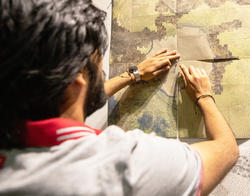
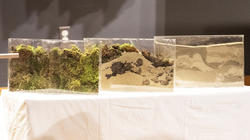
The students passed around samples of “marsh muffins” (natural plant material) they collected at the site and described the process they used to transform it into building materials. “We added water to create a paste and then compression-tested the material and learned that it held up extremely well,” Neuhof explained. They also harvested mussels at the site and integrated them into the recipe to create functional and attractive bowls.
While the reviewers were impressed with the materials and the sophisticated design of the shelter the team proposed, they were concerned about plans to dig channels in the marsh and otherwise disrupt the natural ecosystem. “Marshes have been on the planet for thousands of years,” Bissonnette noted, “and are responsible for important ecological functions, including detoxifying pollutantss and sequestering carbon. Modifying the environment will help some species but harm others and can create a snowball of negative effects.”
Later in the week, students in Johnson’s class shared work with Bissonnette and visiting critics, explaining how they considered nature’s strategies when working on their designs. Sarah Khadraoui 23 TX and Jason Liao 23 ID, for example, took inspiration from the effortless folding of an earwig’s wing. They created multiple iterations of the concept in paper and woven textiles, which they imagine being used to create wall-mounted chairs, shelving units and beds.
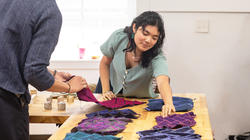
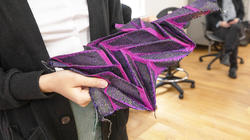
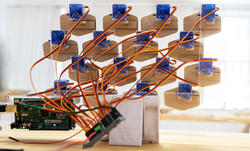
Karim Ismail MADE 23, Ty Ko 23 ID and Anna (Yu Jung) Jung 23 GD developed a system informed by the structure of pine cones that creates customizable air circulation patterns. They demoed a surface treatment for walls using Arduino technology that could be controlled by the user to regulate the airflow within a vehicle or living space. “We see the unit being part of a larger ecosystem that also includes lighting and windows,” the team explained.
Bissonnette described the project as “a great use of biophilic concepts,” and Johnson noted that the team’s ability to collaborate contributed to the project’s success. “I really cannot overstate how much I’ve learned from all of you this semester,” she added.
This summer, 12 of the students will continue to work with Johnson, McPhail and Nature Lab staff for eight weeks in parallel with six sustainability fellows from Hyundai and Kia, who will also be mentored by textiles artist-in-residence Eliza Squibb 13 TX, Nature Lab Staff Biologist Benedict Gagliardi and artist-researcher Alexandra Ionescu MA 21 NCSS. In June, Bissonnette, Gagliardi, Ionescu and Squibb also hosted a group of 15 Hyundai and Kia designers and engineers in the Nature Lab for a one-week intensive on biomimicry.
“We’re excited to see where the research goes from here,” says Missakian. “Through alliances like this one, groundbreaking ideas are born, pushing the boundaries of innovation and shaping a future where art and science converge for the betterment of society.”
Simone Solondz / photos by Jo Sittenfeld MFA 08 PH
June 29, 2023
